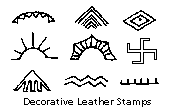What Does this Indian Symbol Mean?
Decorative and symbolic, these designs are seen frequently
Visitors to the Southwest are often intrigued by the variety and aesthetic appeal of the design elements used in Native American arts and crafts. The designs on Indian pottery, weavings, baskets and silver and stone jewelry are so intricate and carefully constructed, it is inconceivable they are not configurations holding some deeper meaning, shaped from a forgotten age, relics of an arcane language, or symbols of some old and secret religion. In all cultures, symbols borrow from experience, vision, and religion and become individualized through the creative process of the artist/symbol-maker. The designs used in the Southwest are from varied sources and they have been adapted and used by divergent tribes. Some have sifted in slowly as different groups arrived bringing their own inventory of designs; others have arrived with new technologies; still others have origins and, therefore, meanings, that will never be deciphered. The designs may be decorative, symbolic or combinations of both. Meanings may change from tribe to tribe. In one location a symbol may have meaning and in an adjacent tribe be used entirely as a decorative element. In short, every variation is possible. If a symbol is produced by one culture and interpreted by another, its meaning is far more often obscured than clarified. So it is with the symbols and designs of the Indian people of the Southwest. Over the years, both Native American designs (merely decorative forms) and symbols (a sign representing an idea, a quality or an association) have been subject to "interpretation" by non-Indian dealers and traders. Often, these interpretations are explained in terms of Anglo-European concepts that were nonexistent to the Native American. The result frequently bears little or no relationship to the true meaning of the symbols. Designs and symbols used in the Southwest actually have come from many places. Some design elements emerge out of the nature of the craft. The warp and weft of baskets or blankets produce a preponderance of geometrics, stars, swastikas and whirlwind designs. One of the most controversial of Native American designs is the swastika. |
 | While the swastika immediately brings to mind Nazi Germany, it is not only a native Southwestern design, it can be called a native design almost anywhere in the world. It is the result of basket weaving where the ends of a simple cross design are turned either to the right or left, depending on the direction of the weaving, to form a swastika. Its meanings are as diverse as its worldwide origins. |
Other designs also have been introduced with the technology of a craft. For example, a host of designs appear in metal dies which were derived from much older stamps used to decorate leather. |
These designs have been called by such fanciful names as rattlesnake jaws, Thunderbird tracks or a medicine man's eye. Others bear more prosaic names such as fence, tipi, mountain range, hogan, sun's rays, headdress or running water. However, in most instances they are purely decorative and their presence may be noted far back in history as elements of cultures other than that of the Native American. |  |
 | In the craft of silversmithing, the Thunderbird is used lavishly on stamped jewelry. The Thunderbird came to the Southwest via industrial dies furnished to Indian artists. |
While it is a symbol of importance among the Plains Indians, this immense bird is neither characterized by the Southwestern Indians, nor do their myths offer explanations. Rather, the bird symbols of importance in the Southwest are the giant Knife-wing of the Zuni or the vulture, Kwatoko, of the Hopi. Nonetheless, the unknown individuals who supplied the dies for the silver felt that the Thunderbird was a "good Indian design" and so it appears on Southwestern jewelry and even on the beams of the Great Hall in the Albuquerque International Airport. |  |
The form of the silver naja, or pendant, at the end of the squash blossom necklace is traceable to Moorish Spain and even farther back in time to a device used to ward off the evil eye. Earlier still, it was found as boar's tusks hanging point-to-point decorating a Roman legionnaire's staff. In the same way, the squash blossom bead emerges from the pomegranate blossoms of Spain. |
 | Despite the multiple origins and mistaken interpretations of designs and symbols used in the Southwest, it is possible to recognize the meanings of many representations used in Native American works. The simplest of all representations is that which characterizes some element of the environment (bird, man, flower, horse, etc.) and is clearly distinguishable. Almost always it is used as a decorative device and nothing more, although its form may vary from tribe to tribe. |
These symbols are frequently seen on the pottery, weavings and jewelry made by Native Americans of the Southwest and generally can be interpreted as indicated. Several other symbols that arise from Native American cultures have become unrecognizable in their new "interpretations" including the butterfly. |  |
 | The snake and lightning or lightning arrow are considered by the native Southwesterner to be a single element as they are the same visual form. The snake does not symbolize "defiance" except possibly in New England, nor is its meaning "wisdom." Lightning is used by Anglo-Europeans indoctrinated in Greek mythology to denote swiftness, but among the Pueblo Indians snakes and lightning are equated with and symbolize rain, hence, fertility. These bird signs are often listed by traders as meaning "carefree or light-hearted," but the symbol is the macaw, a Zuni symbol for summer. |
This is but a glimpse of the rich inventory of Native American designs and symbols which are an integral part of antique and contemporary arts and crafts of this area and, in the form of petroglyphs throughout the Southwest, on the ancient rocks of this ancient land.
http://www.collectorsguide.com/fa/fa040.shtml
http://www.collectorsguide.com/fa/fa040.shtml






